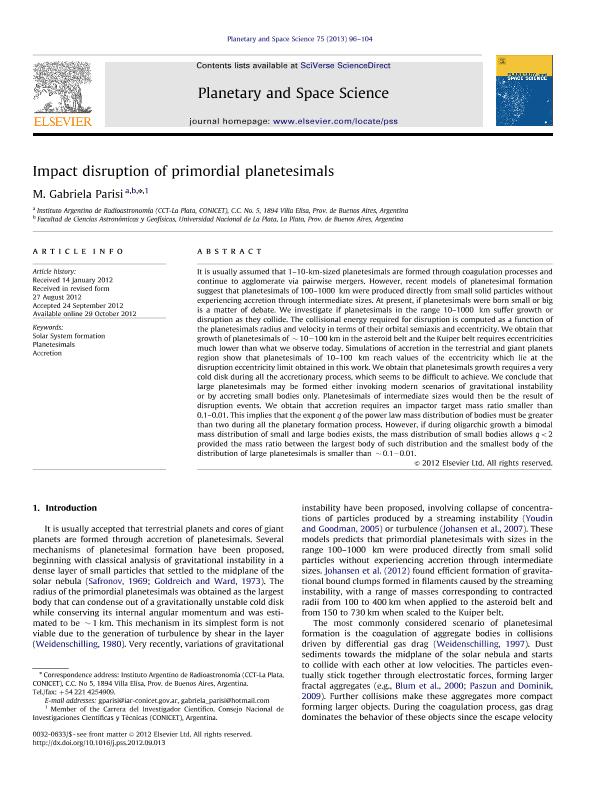Mostrar el registro sencillo del ítem
dc.contributor.author
Parisi, Mirta Gabriela

dc.date.available
2015-12-22T20:36:45Z
dc.date.issued
2013-01
dc.identifier.citation
Parisi, Mirta Gabriela; Impact disruption of primordial planetesimals; Pergamon-elsevier Science Ltd; Planetary And Space Science; 75; 1-2013; 96-104
dc.identifier.issn
0032-0633
dc.identifier.uri
http://hdl.handle.net/11336/3182
dc.description.abstract
It isusually assumed that 1-10-km sized planetesimals are formed through coagulation processes and continue to agglomerate via pairwise mergers. However, recent models of planetesimal formation suggest that planetesimals of 100-1000km were produced directly from small solid particles without experiencing accretion through intermediate sizes. At present, if planetesimals were born small or big<br />is a matter of debate. We investigate if planetesimals in the range10-1000 km suffer growth or disruption as they collide.The collisional energy required for disruption is computed as a function of the planetesimals radius and velocity in terms of their orbital semiaxis and eccentricity. We obtain that growth of planetesimals of 10 -100 km in the asteroid belt and the Kuiper belt requires eccentricities much lower than what we observe today. Simulations of accretion in the terrestrial and giant planets region show that planetesimals of 10-100 km reach values of the eccentricity which lie at the disruption eccentricity limit obtained in this work. We obtain that planetesimals growth requires a very cold disk during all the accretionary process, which seems to be difficult to achieve. We conclude that large planetesimals may be formed either invoking modern scenarios of gravitational instability or by accreting small bodies only. Planetesimals of intermediate sizes would then be the result of disruption events. We obtain that accretion requires an impactor target mass ratio smaller than 0.1-0.01. This implies that the exponent q of the power law mass distribution of bodies must be greater than two during all the planetary formation process. However, if during oligarchic growth a bimodal mass distribution of small and large bodies exists, the mass distribution of small bodies allows q less than 2 provided the mass ratio between the largest body of such distribution and the smallest body of the distribution of large planetesimals is smaller than 0.1-0.01.
dc.format
application/pdf
dc.language.iso
eng
dc.publisher
Pergamon-elsevier Science Ltd

dc.rights
info:eu-repo/semantics/openAccess
dc.rights.uri
https://creativecommons.org/licenses/by-nc-sa/2.5/ar/
dc.subject
Solar System Formation
dc.subject
Planetesimals
dc.subject
Accretion
dc.subject.classification
Astronomía

dc.subject.classification
Ciencias Físicas

dc.subject.classification
CIENCIAS NATURALES Y EXACTAS

dc.title
Impact disruption of primordial planetesimals
dc.type
info:eu-repo/semantics/article
dc.type
info:ar-repo/semantics/artículo
dc.type
info:eu-repo/semantics/publishedVersion
dc.date.updated
2016-03-30 10:35:44.97925-03
dc.journal.volume
75
dc.journal.pagination
96-104
dc.journal.pais
Estados Unidos

dc.journal.ciudad
Amsterdam
dc.description.fil
Fil: Parisi, Mirta Gabriela. Consejo Nacional de Investigaciones Científicas y Técnicas. Centro Científico Tecnológico La Plata. Instituto Argentino de Radioastronomia (i); Argentina
dc.journal.title
Planetary And Space Science

dc.relation.alternativeid
info:eu-repo/semantics/altIdentifier/url/http://www.sciencedirect.com/science/article/pii/S0032063312002887
dc.relation.alternativeid
info:eu-repo/semantics/altIdentifier/doi/10.1016/j.pss.2012.09.013
dc.relation.alternativeid
info:eu-repo/semantics/altIdentifier/url/http://dx.doi.com/10.1016/j.pss.2012.09.013
Archivos asociados
